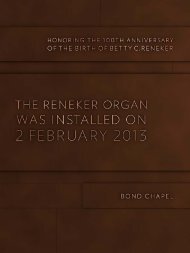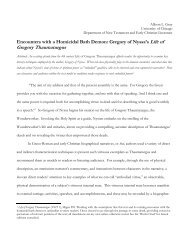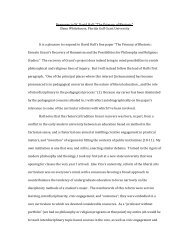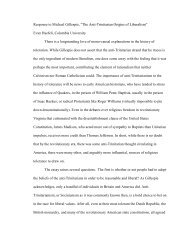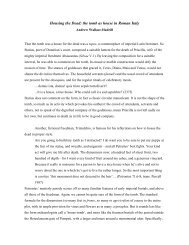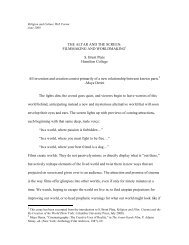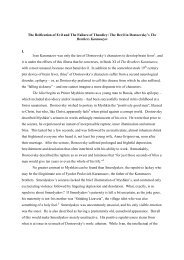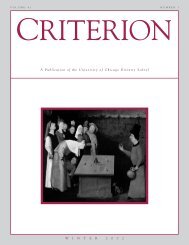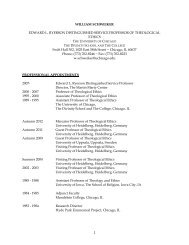Nota Bene - University of Chicago
Nota Bene - University of Chicago
Nota Bene - University of Chicago
Create successful ePaper yourself
Turn your PDF publications into a flip-book with our unique Google optimized e-Paper software.
ornamental leaf (none such appears on the reconstruction <strong>of</strong> the Abercius inscription), and then<br />
a final blessing has been added, one different from Abercius’ own call to those who understand<br />
to pray for him: 62 ει�ρη� νη παρα� γουσιν και� μνη� σκομε�νοις περι� η� μω� ν (“peace be to those who pass<br />
by and make remembrance <strong>of</strong> us”). Hence from the start the physical disposition <strong>of</strong> the<br />
Alexander monument is conspicuously unlike that <strong>of</strong> Abercius in some important respects. This<br />
led some earlier scholars to argue, for instance, for the Abercius inscription being a composite<br />
<strong>of</strong> parts placed on various faces <strong>of</strong> the stone, which could account for the selective retrieval <strong>of</strong><br />
portions from only some sides <strong>of</strong> the Abercius monument onto the Alexander-epitaph.<br />
Whatever one thinks <strong>of</strong> that argument, it does at least push us to reckon with the differences<br />
between the two in physical format rather than assuming one can simply map the textual<br />
disposition <strong>of</strong> the Alexander-gravestone onto that <strong>of</strong> Abercius. Third, the Alexander cippus is<br />
itself has a key anomaly in textual placement, but that is not replicated in the reconstruction <strong>of</strong><br />
the Abercius-epitaph: on the Alexander-cippus the actual text overwrites the borders <strong>of</strong> the text-<br />
panel on both sides (as <strong>of</strong>ten happens), suggesting that even on the smaller scale (without the<br />
hexametric inscription) the physical form <strong>of</strong> the Alexander-stone was actually not a terrific fit for<br />
the inscription. The two Abercius fragments likewise have a border on the left hand and above<br />
line 6, but the text is set neatly inside. Yet we do not know for certain that the stonecutter kept<br />
inside the panel on the right (should one trust more the stonecutter’s practice on the left, or the<br />
epigone’s disposition?!). This observation nonetheless shows that the physical disposition <strong>of</strong><br />
the two is just more complex than the simple invocation <strong>of</strong> “exemplary” form would have it.<br />
Page 18<br />
Fourth, the Alexander cippus differs in physical format from the Vatican reconstruction <strong>of</strong> the<br />
Abercius monument at the top, which was a fluted plinth forming a crown. 63 This difference is<br />
The literary life does not include one within its transcription <strong>of</strong> the epitaph, but does provide a death-date soon after<br />
in the vita proper (vita Aberc. 80 [55]: �Ετελευ� τησεν δε� ο� α� γιος �Αβε�ρκιος μηνι� ο� κτωβρι�ω� κβ� κατα� �Ρωμαι�ους, and this<br />
was <strong>of</strong> course the basis for Abercius’ placement in October within the Menologion traditions. It is also possible that it<br />
was the date marker <strong>of</strong> which the literary author speaks when he mentions that part <strong>of</strong> the inscription had already<br />
been worn away in his time (Simeon Metphrases, Aberc. 77 [Nissen, 122]).<br />
62<br />
ταυ�θ’ ο� νοω� ν ευ�χαιτο υ� πε�ρ �Αβε�ρκι�ου πα�ς ο� συνω�� δο� ς (“Let the one who understands these things pray for<br />
Abercius, every fellow-traveller”), line 19.<br />
63<br />
This is not quite reflected in de Rossi’s drawing, which creates a rectangular top for the fluted ornamental<br />
one sketched, and described in detail, by Mendel (p. 569; compare de Rossi, Inscriptiones christianae urbis romae,<br />
vol. 2 [Rome:Cuggiani, 1888] xviii). Compare also the sharply cropped squeeze in Ferrua, “Nuove osservazioni,”



